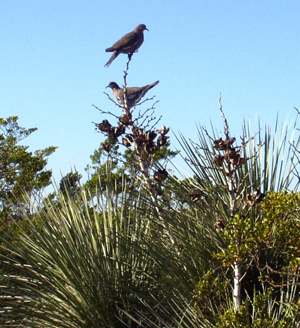Birds
Birds were sought for a variety of purposes by native peoples. In addition to being an important source of meat, birds were valued for their feathers, which could be used in arrows, headdresses, or other ornaments, and their hollow leg bones, which could be used to make beads and even musical instruments. Bird eggs were also sought as a protein source, as evidenced by bird eggshell recovered from Keystone Dam.
The native peoples of the Trans-Pecos exploited a variety of birds. Quail has been identified at Turquoise Ridge, turkey at La Junta, owl at Gobernadora, roadrunner and song birds at Hueco Tanks, and unidentifiable birds at Bee Cave Canyon, Firecracker Pueblo, and Wind Canyon. According to the accounts of late 16th century Spanish explorers, the native peoples who lived along the Rio Grande frequently exploited the migratory water fowl that wintered in the river’s marshes.
Birds were not just economically important to the people of the Trans-Pecos, rockart in the region indicates that they had symbolic importance as well. A peregrine falcon is depicted at a site in the Big Bend and unidentified birds are depicted in the rockart at Hueco Tanks.

